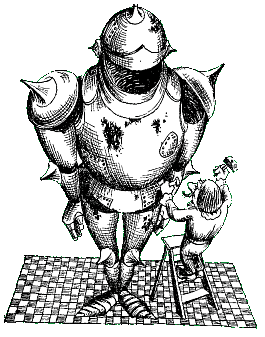107Stories About ChemistryINDEX |
51.
Enemy Number One�
Hundreds and thousands of blast furnaces produce steel and iron all over the world. Economists of different countries scrupulously calculate how many million tons of metal were put out this year and predict the amount to be smelted next year. And the same economists inform us of the astounding fact that every eighth blast furnace operates in vain. Each year about 12 per cent of the metal produced is ingloriously lost to mankind, falls victim to a merciless enemy. . . The name of this enemy is simply rust. Science calls it metal corrosion.  Not only iron and steel perish but the nonferrous metals copper, tin and zinc too. Corrosion means oxidation of metals. Most of them are not very stable in the free state. And even in the air the lustrous surface of a metallic article becomes coated after some time with ominous varicoloured oxide patterns. When oxidized, metals and alloys lose their numerous valuable properties. They become weaker and less elastic and their thermal and electrical conductivities decrease. Once started, corrosion never stops half-way. Slowly but surely the �brown devil� will completely demolish the metallic article. A few oxygen molecules hit the surface of the metal. The first few molecules of oxide are formed. What is called an oxide film appears. It is quite loose and the metal atoms pass through it like through a sieve only to become oxidized immediately in their turn. Also, oxygen molecules pass through the pores of the film into the depths of the metal where they continue their destructive mission. In a more aggressive chemical environment corrosion proceeds more rapidly. Chlorine, fluorine, sulphur dioxide and hydrogen sulphide are no less dangerous enemies to metals. When a metal corrodes under the action of gases, chemists call the phenomenon gas corrosion. And what about various solutions? They are also terrible enemies of metals. For example, ordinary sea water. Huge ocean liners must from time to time be docked for general overhaul, to have the corroded platings of their bottoms and sides replaced. Here is an instructive story about a disastrous blunder an American millionaire once made. He wanted to have the best yacht in the world. He put in an order and thought up a romantic name �The Call of the Sea.� He spared no money. The contractors did their utmost to please their client. It remained only to finish the interior decorations. But the yacht never went to sea; it never had a chance to. A short time before the day the yacht was to be launched its body and bottom were found to have completely corroded. Why? Because corrosion is an electrochemical process. The shipbuilders had decided to plate the bottom of the yacht with a nickel-copper alloy called German silver. It was a good idea because this alloy, though expensive, resists corrosion in sea water very well. It resists corrosion all right, but it is not very strong. And therefore many parts of the ship had to be made of other metals, special steels. And this was the undoing of the yacht. Powerful galvanic cells formed at the points of contact between the German silver and the steel and the bottom immediately began to disintegrate. The end was sad. The millionaire�s grief was indescribable, and the yacht builders remembered ever after one of the laws of corrosion, that its rate increases sharply if to the principal metal are added other metals capable of forming a galvanic cell with it. |





